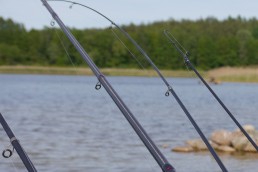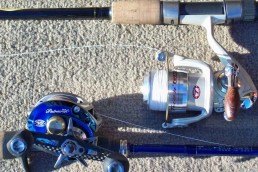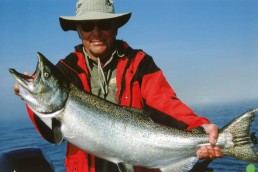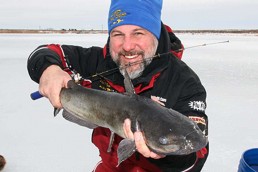SHARE THIS POST
A very memorable fishing story for me involves the day we stopped by to go shore fishing with some friends. Everyone seemed to be catching fish except for that one poor guy with the bad luck. You know, the guy who couldn’t net a fish in a trout pond at a sport show. I went over to see if I could help him out, and hopefully end this poor guy’s night with a little dignity and confidence.
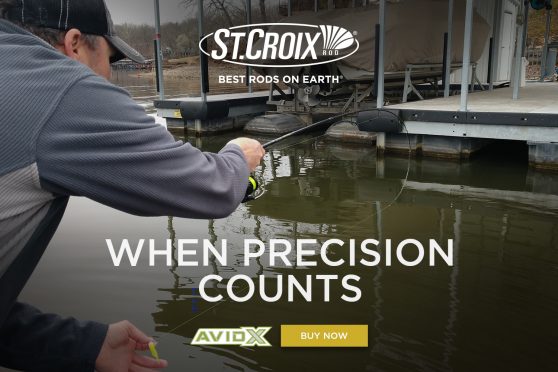 My first question was, “What do you have on your line?” He replied, “Let me show you,” and proceeds to reel up his line. It took him about 3 seconds, yep 3 seconds. He maybe had 8 to12 feet of line out, max. I said, “Well, there’s your problem; just cast a little farther out and you’ll be on the fish.”
My first question was, “What do you have on your line?” He replied, “Let me show you,” and proceeds to reel up his line. It took him about 3 seconds, yep 3 seconds. He maybe had 8 to12 feet of line out, max. I said, “Well, there’s your problem; just cast a little farther out and you’ll be on the fish.”
It was then that I saw the funniest, most dangerous and admittedly somewhat intriguing casting technique I have ever seen, with a total distance of at least 6 feet. Now I knew the problem. This poor guy was fishing not only with the wrong rod, but no one had ever taught him how to cast. Over the next half hour or so, I worked with him to get a cast out good enough to catch fish. Mission accomplished.
The trouble with this story is, you can place most kids, learning how to fish in this guy’s shoes for all the same reasons he was struggling: poor technique, bad line, wrong rod, etc. Fortunately, all of those are easily correctible.
When you’re teaching someone how to fish there are a few things to consider when picking out a rod that fits their abilities. Not matching the rod to the angler usually leads to disappointment, frustration and, in this poor guy’s case…no fish.
First things first. The rod this guy was using was a super flimsy, wrap-it-in-circles-when-you-cast rod. A rod with a slow action and light power are harder for kids to break, and are usually cheaper, so many new anglers start with this kind of rod. Like the guy in our story found out, they can be very difficult to cast.
My rule of thumb for rod action is to start with a fast action rod that is medium- to medium-heavy power, and see how it fits in the angler’s hands. Have them go through some basic casting motions, and see how the rod bends. What I am looking for is a rod stiff enough that the rod does the work, yet soft enough that they aren’t snapping the line or throwing their bait off when they cast. Most of the time, a new angler learns to cast faster, with better accuracy, than they would with a flimsy rod.
The next question to answer is, “What’s the right length rod?” Most people have the fond, cute memories with kids using short beginner rods. Now think back to watching them try to fish with these rods. Hooks fling everywhere, and adults may need to cast for them for safety’s sake.
Casting with a short rod is hard for anyone! If you don’t believe me, here’s a fun experiment. Pull out some short panfish ice rods, and have an accuracy competition with the family in the backyard. Chances are that no one will win.
I like to start out with a rod that is 1 to 1.5 feet longer than the angler is tall, up until the angler reaches about 5 feet in height. For most kids, the mechanics work out best with the weight and size of the rod vs. their arm length. An additional benefit is, the hooks on the line are usually far enough away that you don’t need to become proficient at hook removal.
When it comes to reels, there is a little more to consider. The old standby spincasting reels that most anglers grew up with are most people’s first thought. But, as we have been talking about in this series, you need to look at the capabilities and limitations of each young angler as your starting point.
Are you enjoying this post?
You can be among the first to get the latest info on where to go, what to use and how to use it!
The common thought is that spincasting reels are easiest to learn with. Yet most spincasting reels are big and bulky, making it hard for kids with smaller hands to cast and reel.
Small spinning reels, on the other hand, are easier for kids to hold. Other things to consider are line twist, tangles and drag when picking out a beginner’s reel. I have found that, dollar-for-dollar and time-for-time, spinning reels are the better option because of durability.
The reality is that everyone is different, meaning they all learn in different ways and times. This means that you need to spend a little time with each angler to make a decision, and when it comes to reel choice, expect some trial and error.
Let’s talk a little bit about price. A whole lot more goes into figuring out how much you’re going to spend on a rod and reel than budget. When you consider what we’ve talked about, it doesn’t matter how much you spend on the rod and reel if it doesn’t fit the angler, because it was a waste of money.
Another thing to consider is how much you are willing to spend when the tip is broken or the reel no longer works, because it was dragged through the sand and all of the other incredibly hard things kids do to rods and reels during the learning process. I don’t have any hard numbers, but the rule of thumb that I use is this: I want to spend as much money as necessary to get a rod and reel that is durable enough for at least one fishing season. After all, kids grow quickly, and the rod probably won’t fit them anyway next year.
On the flip side of the coin, I don’t want to spend enough money that it makes me angry when the rod and/or reel is broken. There’s nothing more tragic than watching a kid hate fishing because of getting chewed out because a rod was broken during the learning process. Remember, the goal is, that each time out, new anglers have a positive outdoor experience. Spending the right amount of money on a rod and reel has more to do with this than most people think.
Exception to the rule: Everything that we talked about so far has to do with what it takes to pick out a rod and reel for a kid, allowing them to learn how to cast and catch fish effectively on their own at any age. But when it comes to new anglers, especially little ones, my favorite rod and reel combos are a 6 1/2- to 7-foot rod with a baitcasting reel for use in the boat, and a spinning rod and reel combo when onshore. What I like about this option is, small kids can reel while leaving the rod in the rod holder. When you’re shore fishing, they can sit on the ground and just reel, and in the boat they can stand and reel. This is a great way to get them started with the basic hand-eye coordination needed to take the next step toward getting their own rod and reel and casting on their own.
Finally, you need to get some fishing line on the new reel. When it comes to new anglers, I’m a big fan of cheap monofilament. I generally go with a 6- to 10-pound-test depending on what species we’re targeting. What’s nice about mono is that it breaks easily when you need it to, while being less likely to cut their hands while pulling on snags. It is also less expensive to replace when big tangles happen—and trust me, they will happen, regardless of what reel you’re using. Another nice thing about mono is, it’s easy for kids to learn how to tie knots, and you don’t need any special tools to cut it.
So, as you are hitting the sporting good stores this spring, keep in mind what your young angler’s capabilities are, and what it takes to have a positive outdoor experience when you’re picking out their new rod. MWO
Geremy Olson is an avid outdoorsman, producer and public speaker, 241ink.org, whose son Peter also writes a monthly feature for MidWest Outdoors.
MWO
SHARE THIS POST
Did you enjoy this post?
You can be among the first to get the latest info on where to go, what to use and how to use it!
MWO
We believe being outdoors is good. With more than 1,000 articles each year, MidWest Outdoors magazine is all about sharing outdoor experiences with you—where to go, what to use and how to use it… whether you’re close to home or on that trip of a lifetime.
